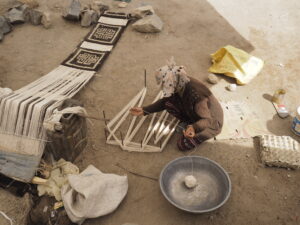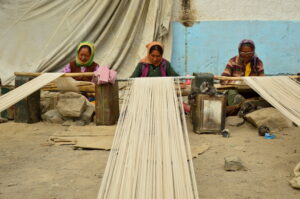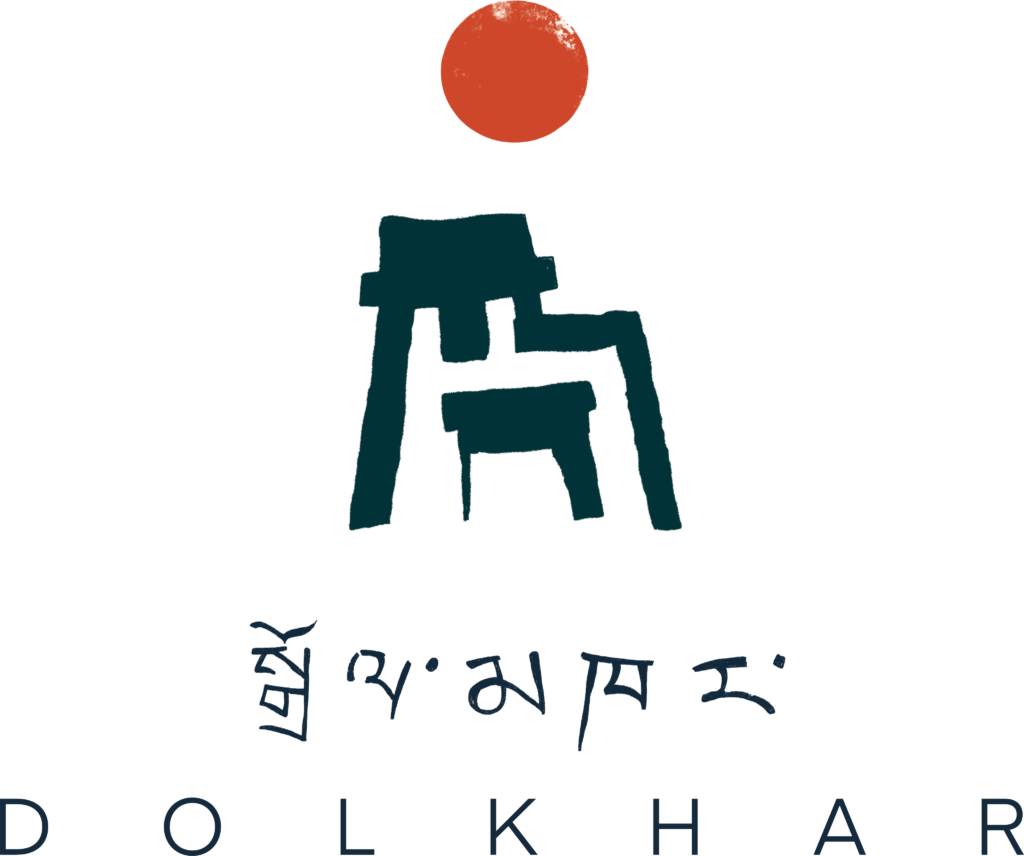Have you ever encountered the charm of hand-woven fabrics? Have you wondered about their origin and history? Have you speculated on the energy, the vital expression, and the passion that went into making them? The beauty and grace of hand-woven fabrics make them unique and extraordinary. These fabrics embody love, hard work, and narratives. Their stories highlight a place’s history and cultural standing, displaying an eternal connection with the past.
In today’s world, there is a growing focus on environments and sustainability. Handmade products play a significant role in sustainable systems. They are made using hands and tools that require no electricity, often without producing pollutants or toxins. The raw materials are locally sourced and can often be reused. Thus, traditionally, no waste is generated in the production process or even after the product has been used. The benefits of handloom weaving make it so precious that it must be preserved, showcased, and passed on to future generations. However, this art is losing its grandeur due to machine-fed consumerism. Machine-made goods are mass-produced quickly, catering to an unaware consumerist market and overshadowing authentic and ethically made products.
Another reason for this art form fading is the constant rural quest for a better standard of life and education. Artists unable to improve their quality of life are forced to migrate to urban areas, resulting in rural-urban migration. This leads to a loss of their talents due to changes in livelihood and lack of practice, which has major cultural consequences.
Kharnak is a village part of the Changthang plateau of Ladakh, mostly comprising nomadic tribes. They rear sheep, goats, cows, and yaks, providing everything they need. These people are known for their skills in crafting and weaving woolen fibers into bags, rugs, ropes, carpets, blankets, and tents. Their raw material is obtained from the wool of goats, sheep, and yaks. These skills have been part of their lifestyle for generations, and their hand-woven woolen fabrics are not only elegant but also warm enough to survive the extreme weather conditions of the plateau. Sadly, Kharnak now has very few such artists, as most have moved to the city (Leh) for better education for their children and better employment opportunities. This migration has resulted in a decrease in the number of skilled artisans in Kharnak, with people leaving behind their homes, livestock, and everything they identify with in search of a “better standard of life.”


Many people from this area have now migrated to a vicinity of Leh city known as Kharnakling. The women of Kharnakling are now reviving the culture they once left behind by weaving woolen rugs, carpets, and bags for the local community. This reconnection with their craft makes them happy, as it feels like a connection to their home. These women have preserved their skills and made a livelihood of their own. They work tirelessly, often without distinction between night and day, to get things done.
Bringing the wool from Changthang and then spinning and weaving it takes a lot of effort. The process of preparing the wool before weaving includes many steps. First, the wool is cleaned, either by washing and drying it or by beating the dirt out of it. Next is the carding process, which turns the fibers into a loose but orderly roll to untangle and clean the wool fibers, making them soft and fine. After this, the wool is spun to obtain a thread using a spindle made of a slender cone of willow wood. These threads are then combined depending on their use. Each woman can perform each step of this process, enabling them to shuffle tasks and be more efficient when needed.
Everyone has a story of their own, inspiring us and making us realize the importance of preserving culture. The stories of these women tell us how the skill has been transferred over generations and how they feel the need to pass it on. The fear of losing their culture, however, can be seen in every woman of Kharnakling.
Sonam Kunkhyen was born and brought up in Chumur, Changthang. Later, she got married and moved to Kharnak, Chanthang. She learned the art of spinning and weaving wool into beautiful products from her mother, a skill every family inherits and passes on to the next generation. She used to rear sheep, goats, and yaks, producing everything at home from dairy products like milk, butter, curd, and cheese to fabrics. Her days were spent looking after the sheep, going to places to rear them, and weaving various products. After her marriage, things were the same until her children started school. In pursuit of better education, her family had to migrate to Leh. They sold all their domesticated animals. The city life was different for Sonam, who was used to working on fields and roaming vast expanses of land with the sheep. In the city, she was bound to her small house, needing to buy everything from a market, an unfamiliar concept for her. Along with other women from Kharnak who had also shifted to the city, Sonam thought of starting hand-weaving work as a way to reconnect with the gift from their mothers. Slowly, they started selling the products and began earning from their skills. Today, during the day, Sonam goes for some labor work, and she spends her evenings with her friends making handmade woolen products. Spinning and weaving give her immense happiness, becoming a social event and a coming together of women from her village. Her products range from small caps and gloves to large carpets. Tourists buy the small products, and carpets are in huge demand from locals, with bulk orders mostly from hotels and resorts. This art gave her an earning and an identity of her own passed on by her mother. However, her children have no idea about the art of spinning and weaving. Sonam believes that if her children want to study now, she doesn’t want to be a barrier to their academic journeys. She hopes that there will come a time when her children will want to learn the skill to take it forward on their own.
Padma Chorol is another woman with a similar story. She too belongs to Changthang valley. During her time in Changthang, she spent her days rearing cattle, spinning, and weaving wool with her mother and grandmother. She used to get milk from the goats and churn out butter from the milk. Things were easier, and all she needed was available to her. However, soon after her kids grew up, she had to send them to Leh. The unavailability of transport and blocked roads in winter made her stay separated from her kids. These situations compelled her to leave her native land and move to Leh with her kids. After coming to Leh, she met other women like her who had also migrated to Kharnakling. They formed a group and started making carpets and other woolen products together. She even taught her kids the spinning process.
The hand-woven products made by the women of Kharnakling are touched with love, care, and innocence. They might probably be the last generation excelling in this art. Wool-processing, from the shearing of sheep to the spinning and weaving, has always been a customary way of life in the region of Changthang. It is believed that the art of weaving first entered the area from Tibet, as the looms used in the two regions closely resemble each other. It is difficult to date when weaving started in Tibet, but the production techniques of the carpet-weaving tradition can be dated back to at least the 5th century. There are also certain differences between Tibet and Ladakh with regards to carpet-weaving. In Tibet, mainly women weave, whereas, in Ladakh, both men and women weave.
Elderly women say that in the past, they used fewer designs in their weaving compared to their modern counterparts. Two factors explaining this could be the influence of Tibetan women living in Rupshu, who weave several designs into their textiles. Secondly, a large number of commercial dyes and a wide range of colored acrylic yarn available in the market. At that time, tie and dyed circles were the only motifs used in weaving. However, some religious symbols are also used as motifs. Buddhist symbols are used to ward off evil spirits and demons. With the arrival of Tibetans in Rupshu, new border designs have also been introduced, such as rgya-nag lcags-ri, representing the Great Wall of China.
Some of the finest quality pashmina and wool in Ladakh is from Rupshu. They say the quality of the fibers depends on how the livestock are cared for and the quality of the grazing lands. Pashmina is a warmer fiber than sheep wool, but it is challenging to weave because the threads break very easily. Goat and yak hair are largely used in the weaving of carpets and blankets. Goat and yak hair is also stronger than refined wool and is used for weaving tents and saddlebags.
This art and culture of hand spinning and weaving is slowly getting lost amidst modernity. However, this can be preserved if it gets the recognition it deserves. People need to know about the beauty of this art and the hard work one puts into making a single carpet. The women of Kharnakling are thankful to the people who buy these products. What makes them happy, though, is the interest of the local population in buying these handmade products because it implies that the people value their culture. A big boost to this art can come from the hotel and tourism industry. Hotels and resorts aiming to give tourists a local feel and environment should have these local handmade products. Many projects like ‘Hatti Ladakh’ and ‘Dolkhar’ are working towards preservation and giving local artisans a platform in the bigger market. Handcrafted products usually cost more due to the work they require. Although machine-made replicas of these products are easy to find and cheaper, they don’t sustain life in the same way. They don’t have stories and lives intertwined between fibers, and it helps to remember that we rise by lifting others.



